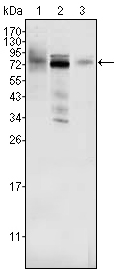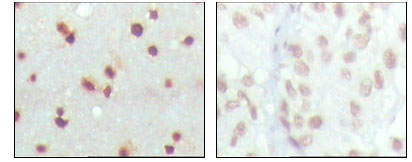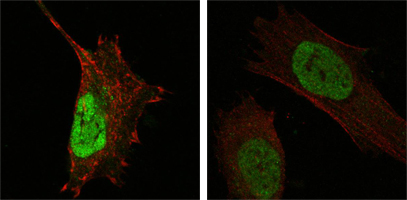MDMX Monoclonal Antibody
- Catalog No.:YM0433
- Applications:WB;IHC;IF;ELISA
- Reactivity:Human
- Target:
- MDMX
- Fields:
- >>p53 signaling pathway;>>MicroRNAs in cancer
- Gene Name:
- MDM4
- Protein Name:
- Protein Mdm4
- Human Gene Id:
- 4194
- Human Swiss Prot No:
- O15151
- Mouse Swiss Prot No:
- O35618
- Immunogen:
- Purified recombinant fragment of human MDMX expressed in E. Coli.
- Specificity:
- MDMX Monoclonal Antibody detects endogenous levels of MDMX protein.
- Formulation:
- Liquid in PBS containing 50% glycerol, 0.5% BSA and 0.02% sodium azide.
- Source:
- Monoclonal, Mouse
- Dilution:
- WB 1:500 - 1:2000. IHC 1:200 - 1:1000. IF 1:200 - 1:1000. ELISA: 1:10000. Not yet tested in other applications.
- Purification:
- Affinity purification
- Storage Stability:
- -15°C to -25°C/1 year(Do not lower than -25°C)
- Other Name:
- MDM4;MDMX;Protein Mdm4;Double minute 4 protein;Mdm2-like p53-binding protein;Protein Mdmx;p53-binding protein Mdm4
- Molecular Weight(Da):
- 55kD
- References:
- 1. Proc Natl Acad Sci U S A. 2002 Dec 24;99(26):16899-903.
2. Cell Cycle. 2004 Apr;3(4):472-8.
3. Biochem Biophys Res Commun. 2005 Jul 8;332(3):702-9.
- Background:
- This gene encodes a nuclear protein that contains a p53 binding domain at the N-terminus and a RING finger domain at the C-terminus, and shows structural similarity to p53-binding protein MDM2. Both proteins bind the p53 tumor suppressor protein and inhibit its activity, and have been shown to be overexpressed in a variety of human cancers. However, unlike MDM2 which degrades p53, this protein inhibits p53 by binding its transcriptional activation domain. This protein also interacts with MDM2 protein via the RING finger domain, and inhibits the latter's degradation. So this protein can reverse MDM2-targeted degradation of p53, while maintaining suppression of p53 transactivation and apoptotic functions. Alternatively spliced transcript variants encoding different isoforms have been noted for this gene. [provided by RefSeq, Feb 2011],
- Function:
- alternative products:Additional isoforms seem to exist,domain:Region I is sufficient for binding p53 and inhibiting its G1 arrest and apoptosis functions. It also binds p73. Region II contains most of a central acidic region and a putative C4-type zinc finger. The RING finger domain which coordinates two molecules of zinc mediates the heterooligomerization with MDM2.,function:Inhibits p53- and p73-mediated cell cycle arrest and apoptosis by binding its transcriptional activation domain. Inhibits degradation of MDM2. Can reverse MDM2-targeted degradation of p53 while maintaining suppression of p53 transactivation and apoptotic functions.,mass spectrometry: PubMed:11840567,similarity:Belongs to the MDM2/MDM4 family.,similarity:Contains 1 RanBP2-type zinc finger.,similarity:Contains 1 RING-type zinc finger.,similarity:Contains 1 SWIB domain.,subunit:Binds to p53, p73 and MDM2.,tissue specif
- Subcellular Location:
- Nucleus.
- Expression:
- Expressed in all tissues tested with high levels in thymus.
- June 19-2018
- WESTERN IMMUNOBLOTTING PROTOCOL
- June 19-2018
- IMMUNOHISTOCHEMISTRY-PARAFFIN PROTOCOL
- June 19-2018
- IMMUNOFLUORESCENCE PROTOCOL
- September 08-2020
- FLOW-CYTOMEYRT-PROTOCOL
- May 20-2022
- Cell-Based ELISA│解您多样本WB检测之困扰
- July 13-2018
- CELL-BASED-ELISA-PROTOCOL-FOR-ACETYL-PROTEIN
- July 13-2018
- CELL-BASED-ELISA-PROTOCOL-FOR-PHOSPHO-PROTEIN
- July 13-2018
- Antibody-FAQs
- Products Images

- Western Blot analysis using MDMX Monoclonal Antibody against HeLa (1), A549 (2) and A431 (3) cell lysate.

- Immunohistochemistry analysis of paraffin-embedded human cerebra (left) and lung carcinoma (right) tissues, showing nuclear localization with DAB staining using MDMX Monoclonal Antibody.

- Confocal immunofluorescence analysis of Hela (left) and L-02 (right) cells using MDMX Monoclonal Antibody (green). Red: Actin filaments have been labeled with DY-554 phalloidin.



